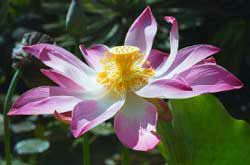Centuries Later, Chinese Lotus Seeds Still Sprout

Nearly 500 years after forming in their parent plant, lotus seeds from a Chinese lakebed have sprouted seedlings of their own, researchers say. According to the lead author of a study detailing the findings, published in the current issue of the American Journal of Botany, the cultivation of offspring from seeds this ancient is “a first in plant biology.”
Biologist Jane Shen-Miller of the University of California, Los Angeles, and colleagues collected 20 ancient lotus seeds on a trip to China’s Liaoning Province. Radiocarbon dated at between 200 and 500 years old, the four seeds that the team tested for viability all sent up shoots. But the plants have not fully escaped the effects of time: all exhibit abnormalities in their leaves, stalks and underground stems. “Instead of standing up straight with strong leaves, these were smaller, the leaves were weak and bent, displayed abnormalities in color, and the underground stems were small and not getting enough food,” Shen-Miller reports. The culprit, she surmises, is long-term, low-dose radiation from the soils in which the seeds resided. (The lotus pictured at the right did not arise from the seeds discussed here.)
Still, the radiation exposure does not appear to have hampered germination. “The lotus is so robust that it can sprout after centuries of exposure to low-dose gamma radiation,” Shen-Miller observes. “We need to learn about its repair mechanisms, and about its biochemical, physiological and molecular properties. The repair mechanisms in the lotus would be very useful if they could be transferred to crops, such as rice, corn and wheat, whose seeds have lifespans of only a few years.”
Media Contact
All latest news from the category: Life Sciences and Chemistry
Articles and reports from the Life Sciences and chemistry area deal with applied and basic research into modern biology, chemistry and human medicine.
Valuable information can be found on a range of life sciences fields including bacteriology, biochemistry, bionics, bioinformatics, biophysics, biotechnology, genetics, geobotany, human biology, marine biology, microbiology, molecular biology, cellular biology, zoology, bioinorganic chemistry, microchemistry and environmental chemistry.
Newest articles

Silicon Carbide Innovation Alliance to drive industrial-scale semiconductor work
Known for its ability to withstand extreme environments and high voltages, silicon carbide (SiC) is a semiconducting material made up of silicon and carbon atoms arranged into crystals that is…

New SPECT/CT technique shows impressive biomarker identification
…offers increased access for prostate cancer patients. A novel SPECT/CT acquisition method can accurately detect radiopharmaceutical biodistribution in a convenient manner for prostate cancer patients, opening the door for more…

How 3D printers can give robots a soft touch
Soft skin coverings and touch sensors have emerged as a promising feature for robots that are both safer and more intuitive for human interaction, but they are expensive and difficult…





















